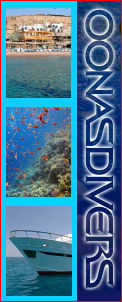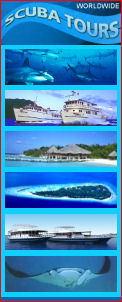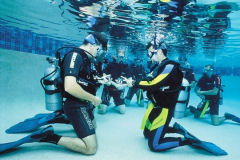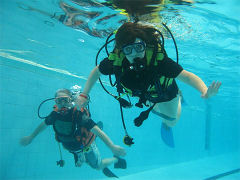|




|
| |
|
|
| |
|
 We
are an active club and diver training is part of our on-going
activities. We have qualified scuba instructors who are able
to train divers to internationally recognised standards. We
are an active club and diver training is part of our on-going
activities. We have qualified scuba instructors who are able
to train divers to internationally recognised standards.
Being affiliated to the Sub-Aqua Association (SAA),
our club follows the SAA training syllabus and is therefore
able to award SAA qualifications which are internationally
recognised by the World Underwater Federation (CMAS).
Diver training commences in the swimming pool. At the
beginning of his or her training, following the initial fitness
assessment, the novice starts by learning proficiency with
the basic equipment i.e. mask, snorkel and fins.
Once
they have demonstrated that they are capable of proficient
use of the basic equipment, the novice then moves on to train
with the SCUBA equipment but before they can use the SCUBA
they must pass a diving medical.
How long a novice takes to progress through the pool
training is largely up to themselves but on average it usually
takes around three or four months to complete this part of
the training.
 The
trainee then moves on to the open water environment to
complete their training. This is usually done in a local flooded
quarry or in the sea. The
trainee then moves on to the open water environment to
complete their training. This is usually done in a local flooded
quarry or in the sea.
Besides the practical training in the pool and the
open water, the trainee must attend a series of lectures covering
the theory of diving. At the end of the lecture series the
trainees must pass a written examination in order to qualify
to their respective grade.
Our club meets for pool training every Monday evening
at 7.30pm in the Llantrisant Leisure Centre. Following this
at 8.30pm onwards, the club meets on level 3 for a club meeting.
This is usually followed by retiring to one of our local pubs
for a social gathering.
|
Please
Note: We can only offer
training to our club members; We are a Sub-Aqua Club,
not a diving school.
|
Besides
the pool training, we also organise days for training
in the open water environment. Some of these are indicated
on our
dive schedule page.
A full
list of all the various SAA Diver Qualifications is given
below:
|
|
|
Diving
Qualification Grades
Novice
A novice diver must complete all pool and relevant classroom
training, as set out in the SAA Qualification Record Book
and Guidance Manual, to the satisfaction of the Club Diving
Officer before being taken on their first open water dive.
A novice must dive with an Open Water Instructor or above.
SAA
One Star Diver
An SAA One Star Diver is fully pool trained in the use of
SCUBA equipment. When diving in open water an SAA One Star
must be accompanied by at least a SAA Three Star Diver or
higher.
If the SAA One Star Diver is receiving any training or examination
during the dive, it must be under the guidance of at least
an Open Water Instructor. An SAA One Star may Dive to a maximum
Depth of 20m whilst under Instruction for OWD.
An SAA One Star Diver may dive to a maximum depth of 35m whilst
under Instruction for SAA Two Star Diver.
1
Star Diver Assessments
SAA
Two Star Diver
A SAA Two Star is qualified to dive in open water and may
dive with others certified to SAA Two Star or higher.
A SAA Two Star is not considered to have sufficient experience
to dive with divers of Elementary or Open Water standards
in open water. If the SAA Two Star is receiving any training
or examination during the dive, it must be under the guidance
of at least an Open Water Instructor.
A SAA Two Star may dive to a maximum depth of 35m and to 50m
under supervision.
2
Star Diver Assessments
SAA
Three Star Diver (Leader)
A SAA Three Star Diver has additional practical experience
and knowledge, and has proven their ability to lead divers
underwater. A SAA Three Star Diver may dive with any grade
of certified diver. A SAA Three Star Diver is not an Instructor
and may not instruct in open water unless qualified as an
Open Water Instructor or above.
3
Star Diver (Leader) Assessments
SAA
Three Star Diver (Supervisor)
A Dive Supervisor is an experienced and responsible diver,
with a proven ability to organise and lead diving expeditions.
A Dive Supervisor is not an Instructor and may not instruct
in open water unless qualified as an Open Water Instructor
or above.
SAA
3 Star Diver (Supervisor) Assessments
|
|
Instructor
Qualification Grades
Assistant
Instructor (AI)
An Assistant instructor may take club trainees through pool
training and lectures on theory or skills up to their own diver
grade under the guidance of a Club Instructor or higher. They
may not assist in open water instruction.
Club
Instructor (CI)
A club Instructor may take club trainees through pool training
and teach theory or skills up to their own diver grade.
May
assist in Open Water Training under the guidance of an Open
Water Instructor.
Open
Water Instructor (OWI)
An Open water instructor may take trainees for their open water
training dives. Only OWI and above can Train a diver in open
water. May work on skills courses (Oxygen Admin, Diver First
Aid, Diver Rescue, Assistant Instructor etc.) under the guidance
of a Regional Instructor or higher provided they already hold
that certification.
Note: The Diver Rescue qualification is now required
in order to qualify as an Open Water Istructor.
Regional
Instructor (RI)
May act as Course Organiser for skills courses, provided they
are certified and current Instructors for that course.
National
Instructor (NI)
National instructor is the highest level of instructor within
the SAA. A National Instructor will usually be actively involved
in shaping and implementing the development of training within
the SAA and the award of this grade is usually based on project
work undertaken at the request of the NDO.
Skills
Discipline Instructor
Can act as an Instructor on Skills Courses. The following skills
discipline Instructor ratings are available:
SAA
Boat Handling Instructor (BHI)
Oxygen Administration/Emergency Diver First Aid Instructor (O2/EDFAI)
Diver Rescue Instructor (DRI)
Nitrox Instructor (EANI)
Extended Range Instructor (ERDI) |
|
|
SAA
Cross Over Guide
Guidance Chart for (approximate) Equivalent Qualifications
| SAA |
BSAC |
PADI |
NAUI |
CMAS |
|
Novice
|
Novice
Diver
|
Open
Water Diver
|
--- |
---
|
| SAA
1 Star |
Ocean
Diver
|
Adv
Open Water Diver
|
Scuba
Diver
|
1
star |
|
SAA
2 Star
|
Sports
Diver
|
Rescue
Diver
|
Adv
Scuba Diver
|
2
star
|
|
SAA
3 Star (leader)
|
Dive
Leader
|
Dive
Master
|
Sports
Diver
|
2
star
|
|
SAA
3 Star (supervisor)
|
Advanced
Diver
|
---
|
Dive
Master
|
3
star
|
|
National
Diver
|
--- |
--- |
--- |
4
star
|
|
See
the crossover page for more info
|
|
|
SAA One Star Diver - Open Water Assessments:
Before
commencing aqualung training, the trainee must satisfy the
Diving Officer that he/she is aware of the hazards of using
compressed air equipment and pressure effects on the body
such as burst lung, reversed ear etc. The trainee should also
sign a declaration form and complete a medical questionnaire.
The SAA One Star Open Water Diver Assessment consists
of an intial open water dive to be carried out at a safe location
and should effectively be the trainee's first open water dive.
The trainee should take part in a supervised dive of at least
15 minutes duration to a depth of at least 10 metres., during
which the following drills should be correctly carried out:
-
Carry
out all pre-dive checks on your own equipment and your
buddy's. The dive plan is to be agreed upon prior to diving.
-
Enter
the water in a safe manner, demonstrate correct buoyancy
and give O.K. signal.
-
Commence
the dive by descending in a safe and controlled manner
paying close attention to correct ear clearing, mask equalisation
and buoyancy control.
-
Demonstrate
the correct use of diver hand signals throughout the dive.
-
At
a depth of at least seven metres, remove, replace and
clear the mask three times.
-
At
a depth of at least seven metres, discard, recover, refit
and clear the mouthpiece three times.
-
At
the end of the dive, demonstrate a safe ascent at the
recommended rate (10 metres per min) including a Safety
Stop at three metres for one minute.
-
At
the surface, exchange signals with cover and inflate the
ABLJ/STAB by any appropriate means. Remove weightbelt
and S.C.U.B.A. and hand to boat/shore cover. Exit the
water, de-kit and de-brief.
Following
successful completion of the initial dive, the trainee
must also complete a further four open water qualifying
dives.
The trainee will also be required to carry out the following
assessments during these qualifying dives:
-
Demonstrate
the correct assembly of the SCUBA equipment, the correct
method of filling the emergency cylinder from the main
cylinder and the correct operation of the ABLJ/STAB including
THREE methods of inflation and TWO methods of deflation.
-
Whilst
correctly weighted, demonstrate neutral buoyancy by hovering
above the seabed without excessive use of arms or fins.
-
Demonstrate
correct buoyancy control by using the "fin pivot"
method.
-
Whilst
underwater, demonstrate the use of an alternative air
supply, (octopus, Air II, Pony, Spare Air, etc.).
-
Carry
out a dive to a depth of 20 metres.
|
|
|
SAA Two Star Diver Assessments:
Before commencing SAA Two Star Diver training, the trainee
must have acheived the SAA One Star Diver qualification.
The trainee should also complete the BCD/ABLJ/STAB course
to the satisfaction of the club Diving Officer, and have completed
a minimum of 10 qualifying dives in a variety of conditions,
each dive to be to a minimum depth of 10 metres with a minimum
duration of 15 minutes. No more than two qualifying dives
to be carried out in the same location or on the same day.
The following assessments should be carried out over a number
of dives under supervision:
-
Swim
250 metres on the surface wearing S.C.U.B.A. breathing
through the snorkel.
-
Rescue
and tow a buddy diver for 50 metres on the surface giving
E.A.R. Land victim, continue E.A.R. and E.C.M. Describe
Aftercare.
-
Demonstrate
correct buoyancy control using the ABLJ/STAB.
-
Demonstrate
the use of an alternative air supply.
-
Demonstrate
horizontal air sharing both as donor and receiver.
-
Demonstrate
vertical air sharing from 5 metres to the surface, including
a safety stop at 3 metres.
-
Diagnose
a suspect decompression problem.
-
Demonstrate
(on land), two methods of recovering an unconscious victim
from depth.
|
|
|
SAA Three Star Diver (Leader) Assessments:
Before commencing SAA Three Star Dive Leader training, the
trainee must have attained the level of SAA Two Star, and
completed a further 15 qualifying dives in a variety of conditions.
No more than two qualifying dives at any one site and on any
one day. At least 8 dives must be sea dives.
It is recommended that the trainee should also have successfully
attended a Basic Boathandling Course and an O2/EDFA Course.
(Not Mandatory).
-
Plan
and carry out a dive to a minimum depth of 30 metres.
-
Act
as SAA Three Star Diver on four occasions.
-
Carry
out an assisted ascent both as donor and receiver from
a depth of 20 metres.
-
Demonstrate
the ability to rescue an unconscious diver from a depth
of 20 metres.
-
Demonstrate
the ability to carry out an emergency ascent from a depth
of 10 metres.
-
Take
part in an underwater rope search using a recognised technique.
-
Plot
a simple underwater navigation course.
|
|
|
SAA
Three Star Diver (Supervisor) Assessments:
Before commencing the SAA Three Star Dive Supervisor training,
the trainee must have achieved the SAA Three Star Dive Leader
Qualification and must have completed a further 25 dives in
a variety of conditions. Not more than 2 qualifying dives
to be carried out in any one day or at any one site.
It is recommended that the trainee should also have successfully
attended the SAA Diver Rescue Course.
-
Organise
and lead four diving expeditions, including two boat dives.
-
Plan
and execute a roped diver search, during which time the
trainee must act as both tender and diver.
-
Plan
and execute a stage decompression stop dive correctly
with necessary stops.
|
|
|
NOTE:
SAA Four Star (National Diver) training is not offered at
club level.
|
|
|